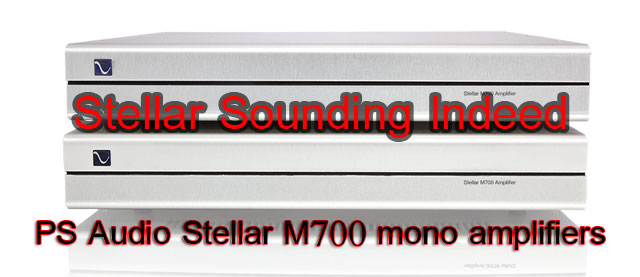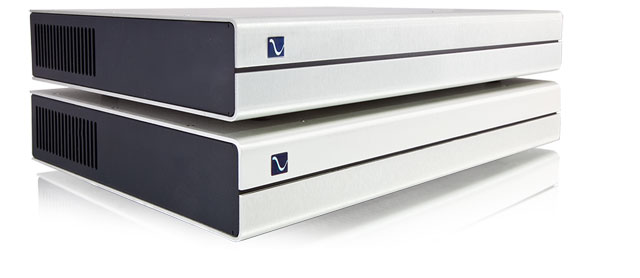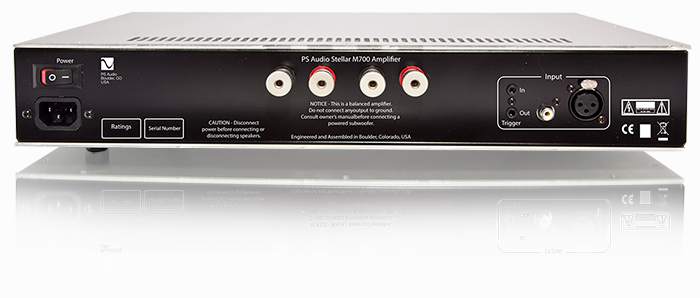PS Audio Stellar M700 mono amplifiers

 A PS Audio 200CX stereo power amplifier (circa 1990) has been a staple in my rig, on long term loan, near as long as I’ve had the Eminent Technology LFT-8b floor standers in my system. At 200 watts per channel, this 70 pound beast provides ample gain to drive my power-hungry, 83 dB sensitive LFT-8b’s. With most other amps, the ET’s fail to deliver, though there have been exceptions, most notably being the Emerald Physics 100.2SE… a great value for its modest 100 WPC into 8 Ohms and additional gain. Other amps often fail the test when pushing these speakers in our large space, so I eagerly agreed when asked if I wanted to review some of PS Audio’s new Stellar components. Shortly thereafter, Clement dropped off a pair of PS Audio Stellar M700 Mono power amplifiers and I was off to the races.
A PS Audio 200CX stereo power amplifier (circa 1990) has been a staple in my rig, on long term loan, near as long as I’ve had the Eminent Technology LFT-8b floor standers in my system. At 200 watts per channel, this 70 pound beast provides ample gain to drive my power-hungry, 83 dB sensitive LFT-8b’s. With most other amps, the ET’s fail to deliver, though there have been exceptions, most notably being the Emerald Physics 100.2SE… a great value for its modest 100 WPC into 8 Ohms and additional gain. Other amps often fail the test when pushing these speakers in our large space, so I eagerly agreed when asked if I wanted to review some of PS Audio’s new Stellar components. Shortly thereafter, Clement dropped off a pair of PS Audio Stellar M700 Mono power amplifiers and I was off to the races.
I installed the Stellar M700 Mono Amplifiers as instructed in the manual, making sure to power them up and unplug them properly as noted. I begin break in process with the Stellar M700’s on my Eminent Technology LFT-8b’s. With the ET’s being the 8 Ohm variety, the M700’s deliver 350 Watts each (700 watts into 4 Ohms). I was immediately taken with the weight of the music even with the M700’s at this initial stage. The ET’s came alive! The sudden immediacy in the presentation was undeniable. The lower bass foundation had both deepened and widened, giving the impression that there were subwoofers alive and kicking in the loft. Both imaging and soundstage were improved with the Stellar’s delivering an added musicality missing until their use. Color me impressed at first blush.


The PS Audio Stellar M700 Mono Power Amplifiers are nicely designed with a low, sleek, industrial look. Available in silver or black, they are understated and pleasing to the eye. The review pair came in a satin silver finish – my wife liked their look immediately. There are no controls on the front, except the On/OFF power button, which also does double duty as a standby control. The rear chassis has two pairs of binding post per side, along with both balanced and unbalanced inputs and IEC connection for power and an on/off switch per unit. The interior of the chassis is a lit with a red LED visible through the side vents. After I saw the red LED illuminated, I hoped a blue LED would kick in once the unit was powered up. Oh well… just a wish on my part.
 PS Audio is fleshing out their Stellar line with some well thought out components – the Gain Cell DAC (preamplifier) with its internal DAC, the S300 stereo amplifier and the M700 Mono Amplifiers offer features to keep them in use for years to come. Paul and PS Audio have really been up to something, so I reached out to Paul to discuss what I was hearing with this the Stellar M700 Monos. I’ve been following Paul McGowan’s audio blog for a while now and he’s beginning to feel like a new audio friend. The following are quotes from the PS Audio website as well as commentary from both Paul and Darren.
PS Audio is fleshing out their Stellar line with some well thought out components – the Gain Cell DAC (preamplifier) with its internal DAC, the S300 stereo amplifier and the M700 Mono Amplifiers offer features to keep them in use for years to come. Paul and PS Audio have really been up to something, so I reached out to Paul to discuss what I was hearing with this the Stellar M700 Monos. I’ve been following Paul McGowan’s audio blog for a while now and he’s beginning to feel like a new audio friend. The following are quotes from the PS Audio website as well as commentary from both Paul and Darren.
Regarding the output stage, the company website offered this: “The hybrid approach used in Stellar’s power amplifiers takes advantage of the best traits technology has to offer. Its all important input stage relies upon the Analog Cell to provide a zero-loss interface between the preamplifier or DAC, as well as imprint the amp’s sonic character. It is then time to convert the perfected analog voltage into the all important high current output needed to drive loudspeakers.” PS Audio engineer Darren Myers’ design delivers an output stage utilizing ultra linear, high-current, Class D technology and an input stage that draws on a discrete, Class A MOSFET based Analog Cell. As PS Audio puts it, “The M700’s rich, warm, and engaging sonic character comes from the Analog Cell. Its powerful, authoritative control over the loudspeaker stems from its high current, ultra-low impedance Class D output stage.”
Paul and Darren Chime In
I wrote Paul McGowan for his take on the M700 Stellar Monos and he reached out to Darren Myers for his take as well. I found their commentary worthy of a full quote here. Paul: “Darren Myers is the lead engineer on this piece and it’s his baby. I helped with the voicing, but basically, Darren gets the credit for this spectacular amplifier. One reviewer commented to us recently that ‘it’s the best sounding class D based amplifier he’s yet heard.’ What surprised him even more was that he’d auditioned other designs using this same ICE Class D module and this still trounced them. The magic is found in the Stellar M700 input stage.”
“The Stellar input stage, known as an Analog Cell, is hand-crafted in the sense that Darren designed it specifically to maximize the synergy between the ICE output stage and this input stage. Most of the work was done by ear, as we do with all our designs. But, let us give you some particulars.”
“The Analog Cell is a Class A biased hand-matched MOSFET differential pair feeding a high-current complimentary MOSFET output stage through a pair of high quality film and foil REL Caps—the same REL caps used in our iconic BHK amplifier series. The MOSFET output stage is then precision servo controlled for zero DC offset feeding into the ICE module. All the values within the Analog Cell are hand tuned by ear in Music Room One on the revealing IRSV loudspeakers.”
“One of the difficulties implementing the ICE module is its hungry demands for a powerful input signal. The 700 watt ICE module has low impedance (around 8KΩ) which, if not properly buffered, can cause plenty of poor sound from connected equipment. And what the designer uses to buffer it is critical. In our case, the Analog Cell handles not only this critical buffering task, but sets the synergy between the input and output. Another innovation employed in service of great performance can be found in the power supply design. Here, the Analog Cell received high quality DC through liberal use of regulation and power supply storage through use of capacitance multipliers and generous numbers of low ESR capacitors.”
Designer Darren Myers added: “Class D amplifiers are tough to make musical and most companies don’t manage to get it right. I can’t tell you the number of class D amplifiers I’ve heard that simply messed up the sound and never conveyed the truth behind the music. Instead, they either colored the sound or veiled the inner detail to disappointment. When we set out to build this amplifier musical accuracy was foremost in our thoughts. The combination of new technologies we developed in the Analog Cell, improvements by ICE in their patented dual feedback module designs, and the revealing powers available to us in Music Room One, all worked in favor of building one of the best amplifiers I have ever been involved with. Stellar’s an amplifier design I am extremely proud of.” The use of two completely independent power blocks also help the M700’s deliver the power they do.
Listening
 Given the sound of the Stellar M700’s Mono’s flat out cold, I was excited to hear them once fully broken in. The Pat Metheny Unity Group’s oft referenced “” (Nonesuch Records Inc. 2014) just jumped from the speakers with tremendous power and presence, thanks to the PS audio amplifiers and my digital source; the Laufer Teknik Memory Player Mini. There was so much more space and energy present than previously experienced in the system and a more realistic and fleshed out soundstage. There was power behind the stage, eliciting a more visual field to the music presented, thanks to a warm, more musical and just more lifelike picture – with dynamics delivered in spades.
Given the sound of the Stellar M700’s Mono’s flat out cold, I was excited to hear them once fully broken in. The Pat Metheny Unity Group’s oft referenced “” (Nonesuch Records Inc. 2014) just jumped from the speakers with tremendous power and presence, thanks to the PS audio amplifiers and my digital source; the Laufer Teknik Memory Player Mini. There was so much more space and energy present than previously experienced in the system and a more realistic and fleshed out soundstage. There was power behind the stage, eliciting a more visual field to the music presented, thanks to a warm, more musical and just more lifelike picture – with dynamics delivered in spades.
Switching gears, I put on Billy Childs’ “Map to the Treasure – Reimagining Laura Nyro” (Sony 2014). This collection of beautiful music always slays and the delivery by the first song was no exception. “New York Tendaberry,” sung by Renée Fleming and accompaniedd by Yo-Yo Ma on cello, was delivered with passion, musicality and a drive previously never experienced. Yo-Yo Ma’s cello was so musical wonderfully rendered here, possessing warmth and truly lifelike character.
 “To A Child,” sung here by Dianne Reeves, to my ear, harkened back to songs as delivered by Dionne Warwick. Reeves’ honey tone and her spot on annunciation were beautiful. The instrumentation gets quite dense in this arrangement, yet through the PS Audio M700 amplifiers, such instrumental images remained distinctly separate yet amply harmonious and lush. There was power present not realized by the vintage PS Audio 200CX amplifier I’ve used for years. Impressive.
“To A Child,” sung here by Dianne Reeves, to my ear, harkened back to songs as delivered by Dionne Warwick. Reeves’ honey tone and her spot on annunciation were beautiful. The instrumentation gets quite dense in this arrangement, yet through the PS Audio M700 amplifiers, such instrumental images remained distinctly separate yet amply harmonious and lush. There was power present not realized by the vintage PS Audio 200CX amplifier I’ve used for years. Impressive.
The next song I played started with the depth far beyond my back wall. Alison Kraus has never sounded so good as on “And When I Die,” accompanied by Jerry Douglas’s slide playing, both of their instruments light and airy, as if defying gravity with both depth and the solidity, presented on a deep and driven foundation.
Gretchen Parlato’s “Juju” from her “Live In NYC” (Obliqsound 2013) had better focus than previously thought. Dynamics and percussive cues possessed greater body and energy – with the backing band members feeling more present. The music had an addictive energetic musicality and authority that brought it absolutely into the room. My foot’s tappin’ and finger’s ‘r snappin’!
 Al Kooper’s “How Am I Ever Gonna Get Over You” from his “Black Coffee” release from 2005 (Favored Nations), is a great cut, with Al’s pleading vocal delivery and beautiful B3 organ work. Cooper’s songwriting is certainly stellar… his not a beautiful voice but it’s got great personality and body here and the music presented by the PS Audio Stellar M700 amps did not disappoint. The low frequencies held a firm grip on the music’s foundation and allowed the music to just flow.
Al Kooper’s “How Am I Ever Gonna Get Over You” from his “Black Coffee” release from 2005 (Favored Nations), is a great cut, with Al’s pleading vocal delivery and beautiful B3 organ work. Cooper’s songwriting is certainly stellar… his not a beautiful voice but it’s got great personality and body here and the music presented by the PS Audio Stellar M700 amps did not disappoint. The low frequencies held a firm grip on the music’s foundation and allowed the music to just flow.
Playing Anouar Brahem’s “Blue Maqams” with Dave Holland, Jack DeJohnette and Django Bates (ECM 2017) things got contemplative. Brahem, a Tunisian oud player and composer of great renown; his oud playing is gorgeous, very tactile and resonant, these players support the music’s trance-like mood very nicely. That mood is often somber and quiet, but it’s also hopeful. This superlative rhythm section was supportive, expressive and the keyboardist talkative without being overly chatty or busy. Such underrated brilliance allowed Brahem the room needed to craft beauty from the space between the notes. Prior to the M700’s entering the house, such a description could not have been conceived – these amplifiers offer the presence and fundamental rightness to deliver such rich tones and textures.
 Petros Klampanis’ Contextual” (Inner Circle Music 2011) Is an album of both simplicity and intensely rich textural composition with a very live and organic air. The playing is beautiful the compositions meaningful. From the rosin on the bows to the plucks on Klampanis’ upright bass, this was a beautifully rendered and remarkable album. The M 700’s did a great job deciphering the textures and presented the dynamics contained herein quite beautifully. These Stellar Monos helped create a real sense of three dimensional instrumentation and Klampanis’ acoustic bass has never sounded better than here. Stringed instruments just jumped to my ears – the bass, guitar and violins were resonant, textural and extremely well-defined. Both macro and micro dynamics punctuate the soundstage and prompt one to feel as though the musicians were performing right in the room. The level of low frequency information has noticeably increased from previously used power amplification and better fleshed out, more immediate and exciting. This recording is that exotic and exciting. Klampanis is quite a composer and player, and “Contextual” represents a milestone in his musical journey. Very well done.
Petros Klampanis’ Contextual” (Inner Circle Music 2011) Is an album of both simplicity and intensely rich textural composition with a very live and organic air. The playing is beautiful the compositions meaningful. From the rosin on the bows to the plucks on Klampanis’ upright bass, this was a beautifully rendered and remarkable album. The M 700’s did a great job deciphering the textures and presented the dynamics contained herein quite beautifully. These Stellar Monos helped create a real sense of three dimensional instrumentation and Klampanis’ acoustic bass has never sounded better than here. Stringed instruments just jumped to my ears – the bass, guitar and violins were resonant, textural and extremely well-defined. Both macro and micro dynamics punctuate the soundstage and prompt one to feel as though the musicians were performing right in the room. The level of low frequency information has noticeably increased from previously used power amplification and better fleshed out, more immediate and exciting. This recording is that exotic and exciting. Klampanis is quite a composer and player, and “Contextual” represents a milestone in his musical journey. Very well done.
A couple of Gino Vannelli’s 1970’s LP’s have continued to receive play over the decades. 1995’s “Yonder Tree,” (Polygram Records) shows his vocal abilities were still Intact 20 years on. Vannelli had a a jazz influence then as now, and it’s nice to see that this album’s arrangements are better-rooted in organic instrumentation than his synthesizer-orientated earlier work… The dynamics were terrific, with a sense of air and space on this expansive soundstage. The bass was big and bold, with great punch and had a nice dimensional feel.
The Wrap
I’ve been putting source material through the rig with the PS Audio Stellar M700’s Mono amps for a month and I have been consistently impressed with their musicality and get up and go. These powerful PS Audio Stellar M700 Mono amplifiers are capable of effortlessly driving demanding loudspeaker loads to concert levels. This may be the first higher-priced component I can’t live with out… but wait, there’s more! At $2995 per pair, they’re not higher priced, just bit of a stretch for my thin wallet. If my 83 dB sensitive speakers have anything to say about it, these review amps have found a new home.

greg voth
Specifications
Price: $1499 single unit / $2998 per pair
• Mono power amplifier pair
• Zero-loss Analog Cell input stage
• Powerful MOSFET balanced output stage
• RCA Single ended input
• XLR “true” balanced input
• 350 watts into 8Ω
• 700 watts RMS into 4Ω
• 2Ω stable
• Less than 0.1% THD 20Hz to 20kHz at rated power
• Damping factor 1100 for excellent loudspeaker control
• Front panel standby button
• Efficient operation with very little heat
• Dual, solid copper, plated, output binding posts
• 27 pounds
• Input 12 volt trigger
Address: PS Audio
4826 Sterling Drive • Boulder, Colorado • 80301
Our office hours are 8AM to 5PM Mountain Standard Time. We are available via email: support@psaudio.com
Website: www.psaudio.com
Email: sales@psaudio.com
Phone: 720.406.8946 voice
Fax: 720.406.8967
Stereo Times Masthead
Publisher/Founder
Clement Perry
Editor
Dave Thomas
Senior Editors
Frank Alles, Mike Girardi, Russell Lichter, Terry London, Moreno Mitchell, Paul Szabady, Bill Wells, Mike Wright, and Stephen Yan,
Current Contributors
David Abramson, Tim Barrall, Dave Allison, Ron Cook, Lewis Dardick, John Hoffman, Dan Secula, Don Shaulis, Greg Simmons, Eric Teh, Greg Voth, Richard Willie, Ed Van Winkle, Rob Dockery, Richard Doron, and Daveed Turek
Site Management Clement Perry
Ad Designer: Martin Perry






Be the first to comment on: PS Audio Stellar M700 mono amplifiers